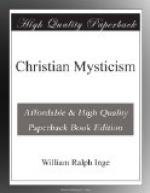[Footnote 8: The analogy used by Plotinus (Ennead i. 6. 9) was often quoted and imitated: “Even as the eye could not behold the sun unless it were itself sunlike, so neither could the soul behold God if it were not Godlike.” Lotze (Microcosmus, and cf. Metaphysics, 1st ed., p. 109) falls foul of Plotinus for this argument. “The reality of the external world is utterly severed from our senses. It is vain to call the eye sunlike, as if it needed a special occult power to copy what it has itself produced: fruitless are all mystic efforts to restore to the intuitions of sense, by means of a secret identity of mind with things, a reality outside ourselves.” Whether the subjective idealism of this sentence is consistent with the subsequent dogmatic assertion that “nature is animated throughout,” it is not my province to determine. The latter doctrine is held by a large school of mystics: the acosmistic tendency of the former has had only too much attraction for mystics of another school.]
[Footnote 9: This distinction is drawn by Origen, and accepted by all the mystical writers.]
[Footnote 10: Faith goes so closely hand in hand with love that the mystics seldom try to separate them, and indeed they need not be separated. William Law’s account of their operation is characteristic. “When the seed of the new birth, called the inward man, has faith awakened in it, its faith is not a notion, but a real strong essential hunger, an attracting or magnetic desire of Christ, which as it proceeds from a seed of the Divine nature in us, so it attracts and unites with its like: it lays hold on Christ, puts on the Divine nature, and in a living and real manner grows powerful over all our sins, and effectually works out our salvation” (Grounds and Reasons of Christian Regeneration).]
[Footnote 11: R.L. Nettleship, Remains.]
[Footnote 12: “Nescio si a quoquam homine quartus (gradus) in hac vita perfecte apprehenditur, ut se scilicet diligat homo tantum propter Deum. Asserant hoc si qui experti sunt: mihi (fateor) impossibile videtur” (De diligendo Deo, xv.; Epist. xi. 8).]
[Footnote 13: From a sermon by Smith, the Cambridge Platonist. Plotinus, too, says well, [Greek: ei tis allo eidos edones peri ton spoudaion bion zetei, ou ton spoudaion bion zetei] (Ennead i. 4. 12).]
[Footnote 14: From Smith’s sermons.]
[Footnote 15: Pindar’s [Greek: genoio oios essi mathon] is a fine mystical maxim. (Pyth. 2. 131.)]
[Footnote 16: Strictly, the unitive road (via) leads to the contemplative life (vita). Cf. Benedict, xiv., De Servorum Dei beatific., iii. 26, “Perfecta haec mystica unio reperitur regulariter in perfecto contemplativo qui in vita purgativa et illuminativa, id est meditativa, et contemplativa diu versatus, ex speciali Dei favore ad infusam contemplativam evectus est.” On the three ways, Suarez says, “Distinguere solent mystici tres vias, purgativam, illuminativam, et unitivam.” Molinos was quite a heterodox mystic in teaching that there is but a “unica via, scilicet interna,” and this proposition was condemned by a Bull of Innocent XI.]




